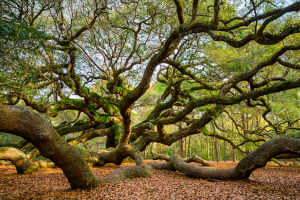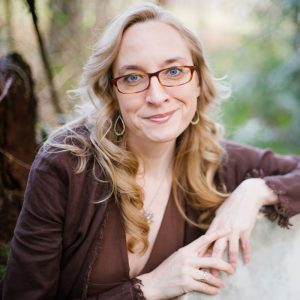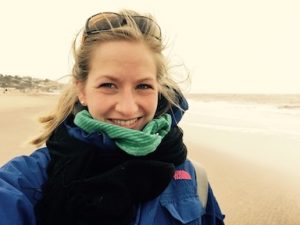Can you imagine a tree 130 feet around at the base, 40 meters in circumference? Can we communicate with the giants? Our first guest Julianne Skai-Arbor (“TreeGirl”) takes us on a world tour of love for the trees, and forest therapy. But can planting billions more trees save us from dangerous climate change? Find out in our second interview, with German scientist Dr. Lena Boysen. This is Radio Ecoshock.
Download or listen to this Radio Ecoshock show in CD Quality (57 MB) or Lo-Fi (14 MB)
GIANT TREE ELDERS, AND FOREST THERAPY – JULIANNE SKAI-ARBOR
We humans have a long and storied relationship with trees. Our nearest relatives the apes and chimps, still call them home. Our short history is loaded with worship of trees, wood craft and lumber, tree medicines, and a long list more.
But public knowledge and reverence for trees declined as we went inside and ride around in machines. For some, it’s coming back as people seek out the forest elders on this planet. You can hire a guide, or you can visit some of the great giants with arborist Julianne Skai-Arbor. Her new book “TreeGirl, Intimate Encounters with Wild Nature” takes you to spectacular trees in many parts of the world.
It sounds a bit risqué, a woman posing naked with some of the world’s largest trees. But this is not forest porno, it’s art. I think it works. Julianne’s body gives us the scale of what we are looking at, it shows your reading of the experience as art, and it tells us about the relationship of humans to trees. It also exposes us as the basic animal that we are, possibly in our original homes, in the trees.
I’ve been pouring through these tree photos over the last few days. It brings back memories of the few great trees I’ve seen, like the Angel Oak in Charleston South Carolina. Even if we are not overtly religious, some trees evoke such a sense of awe.

Keep in mind that both the Greeks and the Romans either revered or met in groves of trees for important religious events. The Celts were famous with their rituals involving great Oaks and the Germanic people worshipped trees. Later, the Catholic Church went to great lengths to end the worship of trees, or meeting in the forest. We are left with only the Christmas Tree.
But it’s not just the West. In Asia, the Banyan tree was where the Buddha had his great revelation. The Hindus believed (in the Bhagavad Gita” that Krishna used the Banyan tree to explain life’s meaning. Sacred trees appear in ancient Egypt and in Africa.
Various trees were also used in medicine. The bark of the White Willow contains a pain-killer almost identical to aspirin. Julianne Skai-Arbor puts one of her gorgeous photographs of a monster tree on one page, and tons of very helpful information on the other. She includes traditional and modern medical uses of many trees. Julianne is also a trained Aborist.
As in California, we also have some magnificent giants on the northern coast of British Columbia. That includes a Yellow Cedar that was over 1800 years old, the oldest tree in Canada.
HEALING YOURSELF WITH TREES
In the interview, we discuss “forest therapy”. That practice began in Japan in the early 2000’s, called “Shinrin Yoku“. The participants move slowly through the trees, trying to bond with some of them. Japanese scientists have studied this, finding that blood pressure and other measurements show positive benefits to this therapy. We can all do it, and a guide is not necessarily required. I’m thinking a lot of people could benefit from this, and not just inner city kids who may never have communed with a tree. Many of us spend more time in cyberspace than on the ground. Do we need to become more rooted, to branch out a little?
Trees also have a built-in memory. Scientists can measure rainfall, storms, and even past climates in the tree rings and the structure of trees. There is a lot to the science of trees.
One important take-home with Julianne is her realization that the giant trees were not really just one entity, but a product and representation of a large community. The tree is home to many creatures large and small. It’s food roots depend totally on many fungi, bacteria and bugs. It all has to work as a whole for a tree to become a centenarian.
Julianne also gives us a half dozen tips for how to “rewild” ourselves.

Julianne Skai-Arbor (“TreeGirl”)
At first I turned this interview down. But going through the book “TreeGirl, Intimate Encounters with Wild Nature” I realized Julianne is giving us a lot. I’m so glad we had the chance to talk about nature’s great creatures, the tree elders.
Because of greenhouse gas emissions, I do not recommend you travel around the world seeking out the great trees. Instead, you can find trees near you, and enjoy Julianne’s collection in her book just out. Julianne’s web site is here, including announcements of upcoming tree workshops for women.
Download or listen to this Radio Ecoshock interview with Julianne Skai-Arbor in CD Quality or Lo-Fi
You can also find a tantalizing three minute video preview of the book here on You tube.
“GREEN” GEOENGINEERING WITH TREES: DR. LENA BOYSEN
Some scientists, including guests here on Radio Ecoshock, have suggested we could plant enough trees to reduce the overburden of carbon dioxide in the atmosphere. We like that idea, it’s our friends the trees, it’s green geoengineering perhaps. But as we’ll hear in our second interview, German scientist Dr. Lena Boysen led a team that tested that out.
Dr. Lena R. Boysen is from the Land in the Earth System at the Max Planck Institute for Meteorology, in Hamburg Germany. She is also associated with Humboldt University in Berlin, and the Potsdam Institute. We reached her at a conference in Brussels.

Dr. Lena Boysen
We begin with a 2016 paper Lena co-authored with Dr. Vera Heck at the Potsdam Institute. That paper asks “Is extensive terrestrial carbon dioxide removal a ‘green’ form of geoengineering?” Is it? Listen to find out.
Download or listen to this Radio Ecoshock interview with Lena Boysen in CD Quality or Lo-Fi
Let’s imagine the year 2050, if our civilization does not contain emissions. The weather is a series of extremes, agriculture is threatened, and rising seas are obvious. The public is in a panic about climate destabilization. What happens to the Earth’s environment if we decide on massive plantations as a solution?
Lena Boysen is the lead author in a paper just published in May 2017 with the title “The limits to global-warming mitigation by terrestrial carbon removal.” On Radio Ecoshock we’ve had respected scientists and authors suggest humanity might save the climate if only we could plant enough trees. What is wrong with that idea?
Boysen ran this idea through a series of runs on one of the world’s top land-system models at the Max Planck Institute in Germany. The results showed how impractical it is to remove significant amounts of carbon through tree plantations. There are a series of problems outlined in the paper, and in our interview. First and foremost, the new plantations would have to be so huge that they (a) impinge on or replace most of natural growth and (b) use up a lot of agricultural land (which means less food for all).
But secondarily, that carbon brought into the trees (in their trunks and roots) has to be captured and stores. Biochar is one way (burning wood with low oxygen and then burying the char). But that would be an almost unimaginably large industrial activity. We could burn the wood in power stations, and then try to capture the carbon coming out of the smokestacks. But no one has perfected that technology – and the captured carbon still has to be stored. We don’t have fool-proof carbon storage tech either.
Essentially, we can improve the planet’s health by planting trees. That is certain. But this scientific paper shows humans cannot count on mass plantation to save us from climate change. It’s much easier, as co-author Hans Schellnhuber says, to reduce emissions now, than to try and capture them later. This paper reinforces the urgent need to slash carbon emissions as quickly as possible – because there is no coming technology to capture that carbon in the future.
I can see that politicians would have an easier time selling the public on plants as the solutions, instead of other geoengineering options, like blotting out sunlight by spraying aerosols high up. We need to warn politicians and the public there is no such easy way out.
Because so many well-meaning experts have offered reforestation or other plantations as a safe solution, the public believe we have this tool. School send little kids out to plant trees to save the climate. Now this new science says “don’t depend on it”.
FORESTS IN OPPOSITE DIRECTIONS
Lena also specialized in another subject which fascinates and worries me. That is the impact of dying forests. We’re told a wide band of the sub-tropics could suffer repeated drought. Could climate change bring mass die-offs in forests in some parts of the world? Is it really possible that the Amazon rain forest, the so-called lungs of the world, could die off due to climate change?
This forest die-off due to warming could come at the same time as humans hope to draw down excess carbon dioxide by mass plantations. These two processes seem to move in opposite directions, possibly at the same time.
The paper “The limits to global-warming mitigation by terrestrial carbon removal” was published in the AGU journal “Earth’s Future” on May 17, 2017. That’s an open-access journal, so you can read both the “Plain Language summary” and the scientific paper itself.
And here is an excellent Press Release from the Potsdam Institute on this paper. It clearly explains our options, in light of this new science.
THE AMERICAN WITHDRAWAL FROM CLIMATE SCIENCE – AS SEEN FROM GERMANY
I was a little surprised that our German scientific guest Lena Boysen seemed not to worry about the Trump administration’s efforts to close down government funded climate science. Sure enough, a few hours later I got this email update from Lena, which she’s permitted me to pass on to you. Lena write:
“I am a boundless optimist but optimism does not set things right and I simply did not realize before attending a meeting in Brussels now that the situation is already very critical. It was an eyeopener to hear that some scientist can’t apply for grants anymore already now and that we need to consider much tighter cooperation with our colleagues in the US. So yes, I personally believe that US scientists will continue their research because it’s way too important and valuable to lose but it will require tough decisions and tremendous efforts of the global research community.”
As I said in the interview, I hope governments in other parts of the world will step into the leadership role in climate research that the United States held up to the 2016 election. We’ve had American climate scientists who assure me the universities will continue. Many of the top Professors have tenure and cannot be fired. There are very progressive universities in the U.S.
My main concern is with NASA which has been feeding the world invaluable data through the science satellites. The twin GRACE satellites have opened our eyes to changes in everything from the shrinking mass of ice on Greenland, to depletion of ground water under California. Some American scientific satellites are aging, and now it looks like we could lose some precious years before they can be replaced.
The good news is that China has begun massive research into climate change and the atmosphere. More and more, I’m seeing experts from mainland China as lead authors on important papers advancing what we know. China is also committed to developing alternative energy technology and deploying it on a massive scale. This can only help us all.
Germany we can count on, for now, as a continuing center of excellence in science of all kinds. But as Lena mentioned, with the move toward Trumpish nationalism in the UK, some science there may be threatened. Centers of climate excellence like the Tyndall Center and the UK Met Office are all government funded. We need that to continue.
Canadian climate science was set back ten years, almost killed off, by the Conservative government of Stephen Harper. It takes part of a generation to rebuild something like that. Australian science has likewise suffered at the hands of the government there.
Governments cutting off climate science when we need it most is strange and dangerous. It’s like shutting down hospitals as the wounded arrive from a major accident or terrorist attack. I presume the drive to cut science is a result of suicidal greed by a few billionaires in the remains of the fossil fuel empire, aided by a willing military-industrial complex, and parts of the mining industry.
Now it’s up to the rest of us to stand up for science. We need to know a whole lot more, not a whole lot less. And we need to get what we know already into the schools, into media, entertainment, and all walks of life. Nothing stands outside the requirement we all have for a stable climate that supports agriculture and all the species. We humans can fail at many things and carry on – but not this.
I’m Alex Smith. Please help me get our many science interviews out to a wider audience. You can browse our past programs loaded with scientists explaining reality. Download them to distribute, or copy the links for Facebook, Twitter, blog comments or whatever. The information is all free – unless a government tries to end our freedoms. Let’s get the spoken word, direct from the lead scientists of the world, into a whole lot more ears.
Thank you for listening again this week.
No disrespect to what ‘tree girl’ does; persuade confused consumers to give her thousands of dollars to be photographed naked in trees whilst being given ‘ecotherapy’, good luck to her. I think, however, this one fell short of the standard of interview integrity I have come to expect from your otherwise valuable, persuasive and informative show. Thank you for all your efforts to cut through all the denial.
Ahh, but recall the subject of the second interview: how our love of trees makes us easy targets for the idea that simply planting enough trees can save the planet from our emissions. It’s a common meme, and politicians love it as “green” geoengineering. I think the first interview delves into our psyche to find out WHY we all, even by instinct, think trees are good and can maybe save us. That was my thinking.
The following shows continue my interviews of leading scientists and science.